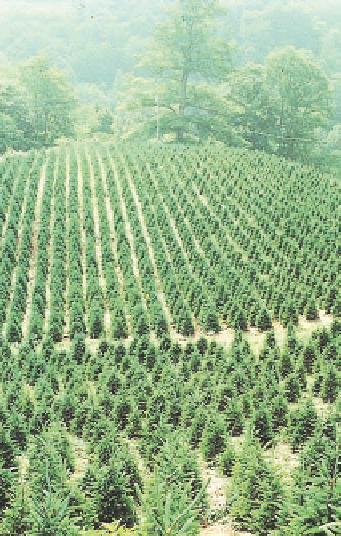Environmental Engineering Reference
In-Depth Information
harvested by clear-cutting as soon as they become
commercially valuable. The land is then replanted and
clear-cut again in a regular cycle.
Natural Capital
Forests
Ecological
Services
Economic
Services
Science and Economics: Types
of Forest Management
Some forests consist of one or two species of
commercially important tree species that are
cut down and replanted; others contain diverse
tree species harvested individually or in small
groups.
Two forest management systems exist. In
even-aged
management,
trees in a given stand are maintained at
about the same age and size. With this approach,
which is sometimes called
industrial forestry,
a sim-
plified
tree plantation
replaces a biologically diverse
old-growth or second-growth forest. The plantation
consists of one or two fast-growing and economically
desirable species that can be harvested every six to ten
years, depending on the species (Figure 8-9).
In
uneven-aged management,
a stand includes a
variety of tree species with many ages and sizes, in an
effort to foster natural regeneration. Here the goals are
biological diversity, long-term sustainable production
of high-quality timber, selective cutting of individual
mature or intermediate-aged trees, and multiple uses
of the forest for timber, wildlife, watershed protection,
and recreation.
According to a 2001 study by the Worldwide Fund
for Nature (WWF), intensive but sustainable manage-
ment of as little as one-fifth of the world's forests—an
area twice the size of India—could meet the world's
current and future demand for commercial wood and
fiber. This intensive use of the world's tree plantations
and some of its secondary forests would leave the
world's remaining old-growth forest untouched.
Fuelwood
Support energy
flow and
chemical cycling
Lumber
Reduce soil
erosion
Absorb and
release water
Pulp to make
paper
Purify water
Purify air
Mining
Influence local
and regional
climate
Livestock grazing
Store
atmospheric
carbon
Recreation
Provide
numerous
wildlife habitats
Jobs
Figure 8-7
Natural capital:
major ecological and economic
services provided by forests.
Figure 8-8
Natural
capital degradation:
tree plantation
in
North Carolina. Some
diverse old-growth
and second-growth
forests are cleared
and replanted with a
single tree (monocul-
ture), often for harvest
as Christmas trees
(shown here), timber,
or wood converted to
pulp to make paper.
This shift from a poly-
culture to a monocul-
ture system de-
creases the area's
biodiversity.
Science and Economics: Harvesting Trees
Trees can be harvested individually from diverse
forests, or an entire forest stand can be cut down in
one or several phases.
The first step in forest management is to build roads
for access and timber removal. Even carefully de-
signed logging roads have a number of harmful effects
(Figure 8-10)—namely, increased erosion and sediment
runoff into waterways, habitat fragmentation, and
biodiversity loss. Logging roads also expose forests to
invasion by nonnative pests, diseases, and wildlife
species. And they open once-inaccessible forests to
farmers, miners, ranchers, hunters, and off-road vehi-
cle users. In addition, logging roads on public lands in
the United States disqualify the land for protection as
wilderness.




